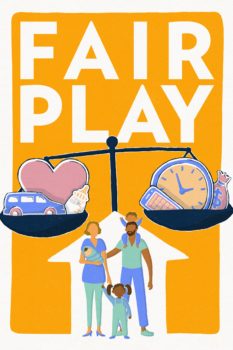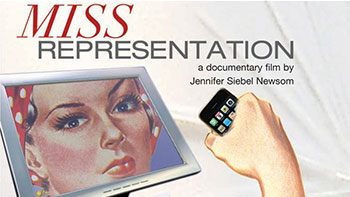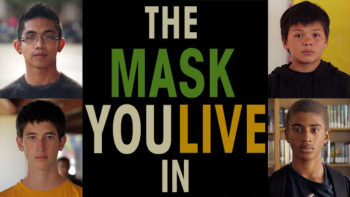[TEXT: Melissa A. Fabello; Philadelphia, PA, USA] So, after my three-part mini-series on the relationship between men and the media – which, by the way, was super successful (thanks, Upworthy!) – I’d like to come back to talking about the media’s influence on women with a vengeance by discussing the girliest contemporary trend in popular music right now. And no, I’m not talking about really adorable, simple lyrics thrown against ridiculously catchy melodies [TEXT: See: Carly Rae Jepsen’s “Call Me Maybe” and Taylor Swift’s “We Are Never, Ever Getting Back Together”]. I’m talking about party girl pop music — the anthems to pre-gaming and morning regret – and more specifically, analyzing the façades of empowerment and liberation that they put forth and whether or not they’re legitimate — or just sexism presented in a different package.
[GRAPHICS. Melissa for Miss Representation. Party Girl Pop Music: Empowerment or Sexism?]
Disclaimer: I am not opposed to the listening to and enjoyment of vapid pop music. It’s entertaining. That’s what it’s supposed to be. Anything that makes me want to sing and dance in the car (to the amusement of the other people waiting at the stop light) is, in my opinion, awesome music. I love the stuff. I own Ke$ha underwear, for God’s sake. What I am opposed to is not using your all-powerful critical thinking skills to analyze what you’re enjoying and what effect it might have on society, as well as what effect society might have on the music industry.
[GRAPHICS. Media Literacy: What It Is – And What It Isn’t]
Let’s review. “Media literacy” is not a scary concept. Contrary to the beliefs of some of my beloved YouTube video commenters – [black and white] “You are a socialist, Marxist drone, and feminism is ruining everyone’s lives” – media literacy isn’t about telling people that what they’re consuming sucks and that they need to be more intellectual in their choices. And it’s not about banning and outlawing any- and everything that upholds patriarchal ideals. Media literacy advocates – like myself! – are not trying to create a warped, feminist version of Fahrenheit 451 – censorship, what!? – but instead, are trying to educate the masses about what it means to think about what you’re consuming. [TEXT: Media literacy is a repertoire of competences that enable people to analyze, evaluate, and create messages in a wide variety of media modes, genres, and forms (Media Literacy).] Think of media literacy as reading nutritional information on a box of packaged food. When you see things like “high fructose corn syrup” and “[word that can’t be pronounced],” you – as an educated individual – know that putting that product into your body is probably not the best idea, that there are better, more nourishing choices out there. But hey. If you know it and want to eat it anyway, more power to you! The important thing is looking, understanding, and making informed decisions. Similarly, when you consume your media diet, you should ask yourself: “What is the content of this product? Is it really selling what it’s advertising? Who made this? And why do they want me to consume it?” Then, proceed accordingly. [eating] Mmm. Delicious.
[GRAPHICS. A Lesson in Faux Empowerment]
In her 2005 book Female Chauvinist Pigs, Ariel Levy writes that “women’s liberation and empowerment are terms feminists started using to talk about casting off the limitations imposed upon women and demanding equality” and suggests that we have since “perverted these words” by applying them to contexts that are undeserving of them (p. 44). That is, because we (as a society) believe on a whole that women have gained equality with men, we’ve started calling things “empowering” when really, they’re actually very limiting. But because we’ve been conditioned to think of them in terms of liberation, rather than sexism, we’re unlikely to analyze them. A simple way to exemplify this is to look at strippers. Many of them (as well as other women in the adult entertainment industry) claim that what they’re doing gives them a sense of empowerment. Now, I’m not saying that they’re wrong or that I whole-heartedly disagree with them. But the question to ask is: Are they really being empowered if they’re subscribing to what’s still a patriarchal ideal, a new-and-not-so-much-improved script for what a woman should be? There is no right or wrong answer here. It’s just something to think about.
Take, for instance, The Spice Girls. In her 2010 book Enlightened Sexism, Douglas discusses a cultural phenomenon (which she dubs “enlightened sexism”) which The Spice Girls (and, God, I love The Spice Girls) manifest: “feminist in its outward appearance (of course you can be or do anything you want), but sexist in its intent (hold on, girls, only up to a certain point, and not in any way that discomforts men or pushes feminist goals one more centimeter forward)” (p. 10). Outwardly, The Spice Girls were all about “girl power,” spreading the idea that women could be anything that they want to be – sporty, posh, scary? – and kick ass doing it. But what my twelve-year-old self didn’t take into consideration was that The Spice Girls were, in and of themselves, caricatures of themselves, each of them representing a “type” of woman, falling into stereotypes themselves. And they did everything in short skirts and hot pants. Not that short skirts and hot pants can’t be feminist, but—[eyebrow]. “Thus, enlightened sexism takes the gains of the women’s movement as a given,” with the media suggesting to and convincing us that internalized misogyny [TEXT: “Internalized misogyny” is defined as misogynistic behavior committed by women (internalized misogyny).] can’t exist, since sexism is irrelevant in 2012, “and then uses them as permission to resurrect retrograde images of girls and women as sex objects” (p. 10). And in the words of Jessica Valenti (2007), “[s]elling a commercialized sexuality to women…as a way to be ‘liberated’ is pretty lame” (p. 42).
[GRAPHICS. Who Owns the Media – And Why Does It Matter?]
“Many producers insist that the mass media are simply mirrors,” Douglas explains, “reflecting reality, whatever that is, back to the public. Whenever you hear this mirror metaphor, I urge you to smash it. Because if the media are mirrors, they are fun house mirrors” (p. 19). The media often claim that they’re giving us what we want, that they are allowing art to imitate life the way that we expect and want them to.
Now, the easiest way to dismantle this myth is to take into consideration that 97% of decision-making clout positions in the media are held by men (Pugh Yi & Dearfield, 2012). Ninety-seven percent. That means that the media that are produced – yes, even (if not especially) the ones that feature representations of women – are produced by people who have no personal stake in making sure that women are represented well. If anything, [TEXT: “Men” as an institution, not necessarily as individuals.] men actually benefit from the misrepresentation, objectification, and sexualization of women: it asserts their position of power. Because if you convince women, by way of manipulating the media, that what’s normal, average, ideal behavior is to drink enough to lower inhibitions and then become a sex machine, who benefits?
So if we take a song like Katy Perry’s 2011 hit “Last Friday Night (T.G.I.F.)” and consider the lyrics “There’s a stranger in my bed / There’s a pounding in my head” combined with “It’s a black-out blur, but I’m pretty sure it ruled,” we also have to take into consideration that she didn’t write that song. Just like Ke$ha doesn’t write her songs. Or Dev, her songs. Or Rihanna, her songs. And on and on and on. The people who are writing those songs? Who are producing those videos? Who are scouting, signing, and representing these artists? Are men. And so it’s men, in turn, as representatives of the media at large, who are also selling us the idea that this is what we want to see, that this stuff is relatable, that this is what’s ideal. That’s a lot of power to have over society.
[GRAPHIC. Party Girl Pop and the Politics of Empowerment]
If you look closely at this new musical trend – which includes young, pretty, mostly white women singing the praises of drunken debauchery and questionable sex acts [TEXT: “Questionable” because of the circumstances surrounding them, not because of the acts themselves.] –what you notice is that the “empowerment” that it is selling (that women have gained sexual equality with men) might not be so empowering if women actually have nothing to gain from it. Although the media try to convince us that party girl pop is a simple reflection of art imitating life, it might really be just a fantasy of power.
“[The media] assure girls and women, repeatedly, that women’s liberation is a fait accompli and that we are stronger, more successful, more sexually in control, more fearless, and more held in awe than we actually are” (Douglas, 2010, p. 5). Think about it: a social stigma still exists that says that promiscuous women (or, really, just any woman who is control of her sexuality) shouldn’t be respected and shouldn’t be trusted, whereas (ohh, double standards) promiscuous men are generally considered to be—well—just men being men. Where’s the equality in that? Where’s the liberation in that? There isn’t any. Women aren’t sexually liberated in a societal sense. We’re sexually oppressed. And pretending otherwise, by buying into this bullshit, bubblegum notion of empowerment, is kind of irresponsible. Valenti posits that perhaps “the joke is on us, and that we’re really just fooling ourselves” (p. 47).
[GRAPHIC. Implications]
Now, I’m not saying that female empowerment and liberation don’t exist. I’m not even saying that they don’t exist in the very songs and genre that I just ripped apart. It’s not that sex can’t be empowering, or that adhering to these new “party girl” social norms can’t be liberating. The problem is when we assume that we actually came to these conclusions on our own, without the influence of the media telling us what we should believe and accept as truth. And that’s what media literacy is all about – reading between the lines (or, in this case, the lyrics) to find what’s there for us – and what isn’t.
In Douglas’ words, “Something’s out of whack here. If you immerse yourself in the media fare of the past ten to fifteen years, what you see is a rather large gap between how the vast majority of girls and women live their lives, the choices they are forced to make, and what they see – and don’t see – in the media” (p. 4). And I don’t think that it’s a coincidence that what we’re being shown in the media about women is a sort of faux empowerment revolving around a freedom to express our sexuality. Because we’re not being shown how to have healthy sexual relationships, how to make sure that we’re experiencing pleasure, how to love and accept our bodies – hell, even how to make sober decisions when it comes to sex. And all of that? Would be liberating. Would be empowering. Instead, we’re being thrown the same old boring stereotypes and contradictions about the relationship between sex and power. Levy asks, “How is resurrecting every stereotype of female sexuality that feminism endeavored to banish good for women?” (p. 4). And maybe it’s about time that we actually stop and think about it.
So, do I think that this nonsense is the devil, that it should be avoided entirely, or that we’re brainless drones with no ability to think for ourselves? No. Not at all. What I think is that it’s important for us to use our powerful critical thinking skills to analyze something really worthwhile – ourselves. And while I don’t agree with everything that Levy or Douglas says about their respective theories, I do think that it’s food for thought. So the next time that Ke$ha comes on the radio, should you shut it off? No. But you should listen responsibly.
[GRAPHIC: Connect with Melissa. Twitter @rev_melissa. Tumblr fuckyeahmelissafabello.]
References and Resources
American Medical Association (AMA). (2006). Sex and intoxication more common among
women on spring break [Press release]. Retrieved from
https://www.rwjf.org/vulnerablepopulations/product.jsp?id=21831
Douglas, S.J. (2010). Enlightened sexism: The seductive message that feminism’s work is done.
New York, NY: Times.
internalized misogyny. (2009, April 12). Wiktionary, The Free Dictionary. Retrieved
September 4, 2012 from https://en.wiktionary.org/wiki/internalized_misogyny
Levy, A. (2005). Female chauvinist pigs: Women and the rise of raunch culture. New York, NY:
Free Press.
Media Literacy (n.d.). In Wikipedia. Retrieved September 4, 2012 from
https://en.wikipedia.org/wiki/Media_literacy
Perry, K. (2011). Last Friday Night (T.G.I.F.). On Teenage Dream. New York, NY: Capitol.
(2010).
Pugh Yi, R.H. & Dearfield, C.T. (2012). Women’s Media Center Report: The status of women in
the U.S. media 2012. Retrieved from
https://wmc.3cdn.net/a6b2dc282c824e903a_arm6b0hk8.pdf
Valenti, J. (2007). Full frontal feminism: A young women’s guide to why feminism matters.
Berkeley, CA: Seal Press.



